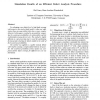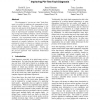12 search results - page 2 / 3 » An experimental analysis of spot defects in SRAMs: realistic... |
ETS
2010
IEEE
13 years 3 months ago
2010
IEEE
ÑIn this paper, we present a comparative study on the effects of resistive-bridging defects in the SRAM core-cells, considering different technology nodes. In particular, we analy...
ITC
1994
IEEE
13 years 9 months ago
1994
IEEE
For obtaining a zero defect level, a high fault coverage with respect to the stuck-at fault model is often not sufficient as there are many defects that show a more complex behavi...
DAC
2000
ACM
13 years 9 months ago
2000
ACM
Real defects (e.g. stuck-at or bridging faults) in the VLSI circuits cause intermediate voltages and can not be modeled as ideal shorts. In this paper we first show that the trad...
ASPDAC
2001
ACM
13 years 8 months ago
2001
ACM
Loical defect diagnosis is a critical yet challenging process in VLSI manufacturing. It involves the identification of the defect spots in a logic IC that fails testing. In the la...
ITC
2002
IEEE
13 years 9 months ago
2002
IEEE
The advantage to “one test at a time” fault diagnosis is its ability to implicate the components of complicated defect behaviors. The disadvantage is the large size and opacit...


